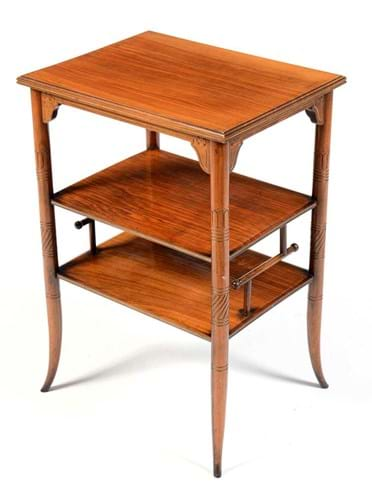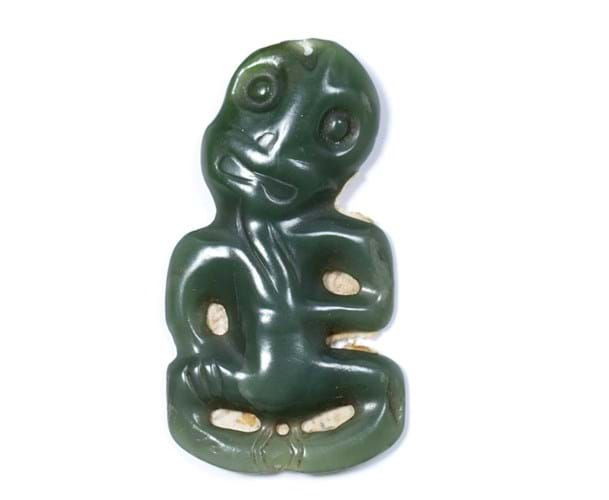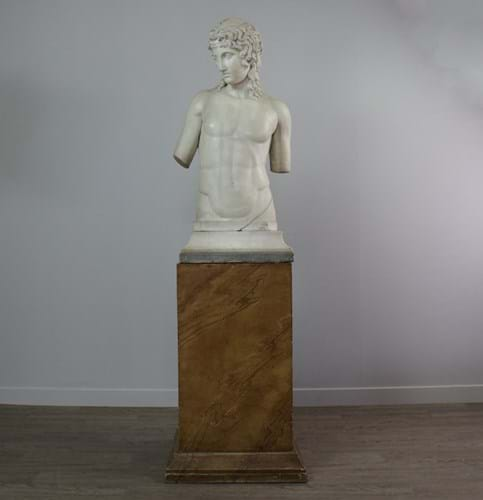1. EW Godwin coffee table – £8500
Although not catalogued as such, this occasional table, above, offered by Anderson & Garland in Newcastle is made to a well-known Aesthetic movement design by EW Godwin.
A table with the same ‘Japanese’ elements is pictured in The Secular Furniture of E. W. Godwin (Susan Soros, 1999) while the model also appears is a line drawing created for the 1877 brochure Art Furniture issued by the manufacturer William Watt. The model, described by Godwin as a ‘Coffee Table’ was also made by Gillows & Co.
A fine example in black and gilt was sold by Lyon & Turnbull in Edinburgh in 2020 for £17,500. The present example emerged for sale on September 14 with a guide of just £100-200 but was spotted by enough bidders to bring £8500.
2. Maori hei-tiki pendant – £30,000
This Maori hei-tiki pendant has an old paper label on the back stating that it originally belonged to Makoare Te Taonui. He was one of 13 rangatira (hereditary Māori leaders) in New Zealand to sign a letter addressed to William IV in 1831 that sought the king's protection against the French and led to the Treaty of Waitangi on February 12, 1840.
He died in September 1862 and is buried at the Williams Memorial Church in Paihia.
More recently this 3in (7cm) green nephrite tiki was inherited by the vendor from an uncle who had owned an antique shop in Gloucester in the 1950s and 60s. He had bought it in 1959 for £10.
It came for sale at Mallams in Oxford on September 16 with a guide of £600-800 but found many admirers, ultimately selling at £30,000.
3. Marble sculpture – £18,000
Across two days, September 17-18, Glasgow firm McTear’s sold the contents of 19 St Bernard’s Crescent, Edinburgh – the private collection of William Mowat-Thomson (1933-2019).
From modest beginnings on Orkney, he became a well-known teacher of dance and drama and a collector who liked to furnish in the grand Georgian style.
Leading the sale was this Carrara marble Grand Tour sculpture of a youthful Apollo. Standing 1.73m high on a scagliola plinth, it took £18,000, many times the modest estimate of £600-800.
4. A letter from Ernest Henry Shackleton – £18,000
Having been demobilised in March 1919, the great Polar explorer Ernest Henry Shackleton had been 'reduced to lecturing on the Endurance twice daily at the Philharmonic Hall in Great Portland Street’ by December of that year.
However, his extraordinary achievements in the Antarctic had not been forgotten. In this letter penned from the Marlborough Club, Pall Mall to the artist Charles Buchel, Shackleton discusses sitting for a portrait.
He apologises that a 'rush of work has prevented me from going up to you' but suggests that 'I'll come for a final sitting directly after Xmas’. The result was the oil now held by the National Gallery of Ireland.
Such is the esteem in which Shackleton is now held by collectors of Heroic Age Polar material, this brief missive guided at £600-800, took £18,000 as part of a Travel & Exploration sale at Bonhams Knightsbridge on September 14.
5. Stanley and Livingstone tree fragment – £2400
A section of wood taken from the tree where Stanley met Livingstone in 1871 sold for £2400 at Sworders Fine Interiors auction on September 14-15.
The memento, a witness to a famous moment in the history of the British empire, came for sale from the family of the man who saved it from a skip years after it had been donated to Edward Higgins, the leader of the Salvation Army in 1931.
Scottish explorer and missionary Dr David Livingstone (1813-73) had completely lost contact with the outside world for six years when Henry Morton Stanley (1841-1904) was sent to Africa to find him by the New York Herald newspaper in 1869.
He found Livingstone in the town of Ujiji on the shores of Lake Tanganyika on November 10, 1871, supposedly greeting him under a mango tree with the words "Dr Livingstone, I presume?"
During the early 20th century a series of makeshift memorials were erected at Ujiji to commemorate the meeting. After the British took over the Tanganyika Territory in 1919, grafts were taken from the mango tree (which was no longer bearing fruit) and successfully replanted close by. The old tree was finally cut down in 1930 and sections of its trunk saved for posterity – one piece placed in the museum of the Royal Geographical Society.
The piece at Sworders, measuring 21cm across, has a simple silver plaque engraved with the inscription Section of the Mango Tree under which Stanley met Livingstone in 1871 sent from Ujiji to General Higgins in 1931. It was almost discarded in the mid 1970s when the old Salvation Army building in Holborn was refurbished.










